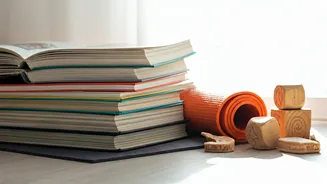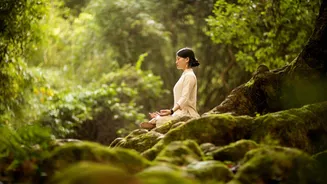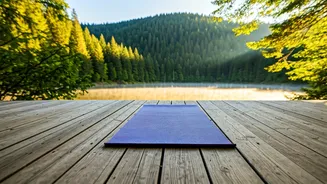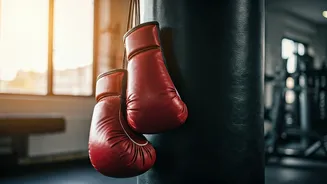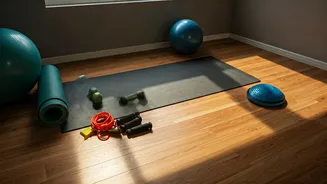Introduction to Yoga
Yoga, an ancient practice, offers a multitude of benefits, extending beyond physical fitness to encompass mental clarity. For children, yoga provides a playful
approach to enhance memory and concentration. Regular practice of specific asanas can improve blood flow to the brain, which enhances cognitive function. These poses also encourage better posture, body awareness, and stress reduction, contributing to an overall sense of well-being. Incorporating these poses into a child's routine can be a fun and effective way to support their mental development and improve their ability to focus on tasks, whether at home or in school. The gentle nature of yoga makes it suitable for all children, regardless of their fitness level, and can be easily adapted to suit different needs and abilities.
Mountain Pose (Tadasana)
Mountain Pose, or Tadasana, serves as a fundamental yoga pose and is excellent for building a strong foundation. To begin, have your child stand tall with their feet together and arms at their sides, as if they are a strong, unmoving mountain. Encourage them to feel the ground beneath their feet, grounding themselves. Instruct them to lengthen their spine, keeping their shoulders relaxed and their gaze forward. Mountain Pose improves posture and fosters a sense of stability and calmness. It also helps children become aware of their body and center their energy. The practice of Tadasana enhances balance and focus, laying a groundwork for other, more complex yoga poses. Children can hold this pose for a minute or two, breathing deeply to maximize its calming benefits.
Tree Pose (Vrksasana)
Tree Pose, or Vrksasana, is a pose designed to enhance balance and focus, requiring children to concentrate and remain steady. In this pose, the child should begin standing straight with arms at their sides. They can then lift one foot and place it on their inner thigh or calf of the standing leg, avoiding the knee. Then, they should bring their hands together at their chest in a prayer position. Encourage them to find a fixed point to gaze at to maintain balance. Tree Pose promotes both physical and mental strength, which improves concentration and coordination. This pose strengthens the leg muscles, improves balance, and fosters a sense of inner calm. It is a great exercise for enhancing the ability to stay focused and grounded, even when faced with challenges.
Warrior II (Virabhadrasana II)
Warrior II, or Virabhadrasana II, is a dynamic pose that boosts both strength and stamina while improving focus. The child should start with their feet wide apart, one foot turned outwards, and the other towards the side. They should bend the front knee over the ankle, keeping the back leg straight and strong. The arms should be extended to the sides, parallel to the ground, with the gaze focused over the front hand. Warrior II enhances both physical and mental resilience, promoting stability and focus. It strengthens legs, arms, and core muscles while improving balance. The controlled movements also encourage mindfulness, helping children concentrate better. This pose fosters a sense of empowerment, helping children feel more confident and in control.
Triangle Pose (Trikonasana)
Triangle Pose, or Trikonasana, promotes both balance and flexibility while stimulating the mind. Instruct the child to stand with their feet wide apart, turning one foot out and the other slightly inwards. They can then extend their arms to the sides, and gently bend to one side, bringing one hand towards their ankle or shin and reaching the other arm towards the ceiling. Their gaze should be directed upward or forward. Triangle Pose improves concentration and body awareness, encouraging mindful movement and enhancing overall cognitive function. It stretches the spine, strengthens the legs, and improves balance. This pose supports better posture and increases alertness, which can help improve focus. It can be a very helpful addition to their yoga routine.
Downward-Facing Dog (Adho Mukha Svanasana)
Downward-Facing Dog, or Adho Mukha Svanasana, is a versatile pose that provides both a stretch and a calming effect, improving focus and concentration. Have your child begin on their hands and knees, then lift their hips towards the ceiling, forming an inverted V-shape. They should keep their hands shoulder-width apart and their feet hip-width apart. Downward-Facing Dog increases blood flow to the brain, which in turn enhances mental clarity and focus. It stretches the entire body and invigorates the mind, which can help reduce stress and improve overall cognitive function. This pose is also excellent for improving strength and coordination and is a valuable addition to any yoga routine for children. Encourage deep breathing to maximize the calming effects.
Child's Pose (Balasana)
Child's Pose, or Balasana, is a resting pose that fosters relaxation and reduces stress. The child should kneel on the floor and gently fold forward, resting their forehead on the ground while their arms are extended forward or alongside their body. Encourage them to breathe deeply. This pose is a valuable tool for stress reduction and improves calmness, which enhances focus. It gently stretches the back and shoulders, while allowing the mind to quiet down. Child's Pose gives children a break from more active poses, offering a moment of stillness that strengthens their ability to concentrate. This simple yet effective pose is a must-have in any child's yoga practice.
Cobra Pose (Bhujangasana)
Cobra Pose, or Bhujangasana, is designed to stimulate the mind and improve alertness. The child should lie on their stomach with their hands placed under their shoulders. They then push up slightly, lifting their chest off the floor, keeping their elbows close to their body. Cobra Pose strengthens the back muscles and stimulates the abdominal organs, fostering an improvement in focus and energy levels. It enhances posture and encourages the flow of energy throughout the body, helping children to feel more alert and ready to concentrate. This is an engaging pose that children often enjoy, contributing to a positive yoga experience. Proper breathing is key for maximizing the benefits of this pose.
Seated Forward Bend (Paschimottanasana)
Seated Forward Bend, or Paschimottanasana, promotes relaxation and can help soothe the mind, increasing focus. Have the child sit on the floor with their legs extended straight in front. They should then reach forward, grasping their toes or ankles while keeping their back straight. This pose calms the mind and enhances focus, while reducing stress. It stretches the spine and hamstrings, promoting flexibility. The controlled movements also encourage mindful breathing, supporting concentration. This gentle yet powerful pose can be part of a calming bedtime routine or as a part of a class. The focus on breathing supports mental clarity and helps children feel centered and calm.
Butterfly Pose (Baddha Konasana)
Butterfly Pose, or Baddha Konasana, is an excellent pose for relaxation and mental clarity. Instruct the child to sit on the floor, bringing the soles of their feet together, and hold their ankles or feet. They can then flap their legs like a butterfly’s wings. This pose stimulates the mind while fostering a sense of peace. It opens the hips and inner thighs, enhancing flexibility and relaxation. Butterfly Pose promotes deep breathing, which in turn enhances concentration and supports overall cognitive function. Children can adapt the pose to fit their comfort level, ensuring an enjoyable experience. Regular practice can lead to a calm mind and an improved ability to focus, making it a great addition to their yoga practice.


